Fattorini H.O., Kerber A. The Cauchy Problem
Подождите немного. Документ загружается.


6.6. Miscellaneous Comments
377
f(A)g(A). An instance of an operational calculus for a fairly arbitrary
unbounded operator A was sketched in Example 3.12: as seen in Section
6.4, this calculus is essentially sufficient to define fractional powers of
certain operators (but not of those satisfying only (6.3.1)). For information
on operational calculi, see Hille-Phillips [1957: 1], Dunford-Schwartz [1958:
1], Balakrishnan [1959:
11, Kantorovitz [1970: 1], Faraut [1970:
1], and
Hirsch [1972: 2]. In the Hilbert space case, advantage can be taken of the
"reduction to self-adjoint operators" outlined in Section 3.8(b)): see Sz.-
Nagy-Foias [1969: 1].
In view of some of the applications, it is important to compute the
fractional powers of ordinary and partial differential operators, or at least
to identify their domains. This is no easy task, and the results are sometimes
less than intuitively obvious.
6.6.2 Example (Yosida [1978: 1]). Let E = L2(- oo, oo), Au = u" with
domain consisting of all u E E such that u" (taken in the sense of distri-
butions) belongs to E. Then A satisfies (6.3.1) (in fact,
it belongs to
(2+ (1, 0)). The operator - (- A )1/2 is the singular integral operator
-(-A
)1/2U(X)=
lim
1 r- u(x - )-u(x)
d (6.6.4)
h-O+
?TJ_0
t2+h2
with domain D((- A)'/2) consisting of all u E E such that the limit exists in
the L2 sense (and not the first derivative operator Bu = iu' as one may
expect). However, we do have
D((- A)1/2) = D(B).
To prove these statements we do not need the general theory of fractional
powers since A is a self-adjoint operator. Through the Fourier-Plancherel
transform, A is equivalent to the multiplication operator Au(a) a2u(a)
in LQ, thus (- j)1/2U(0) _ I a I u(a) and formula (6.6.4) is an immediate
consequence of the fact that
00
etax
'T
dx=he'
oox2+h2
We note that
B2=-A
and the "discrepancy" between (- A)'/2 and B is in fact a consequence of
the fact that if a is a real number, a 2 equals a and not a. In fact, we
have (in the sense of the functional calculus for self-adjoint operators)
(-
A)',2
= IBI
For results on the identification of fractional powers of differential opera-
tors see the treatise of Triebel [1978: 1] and bibliography therein, Evzerov
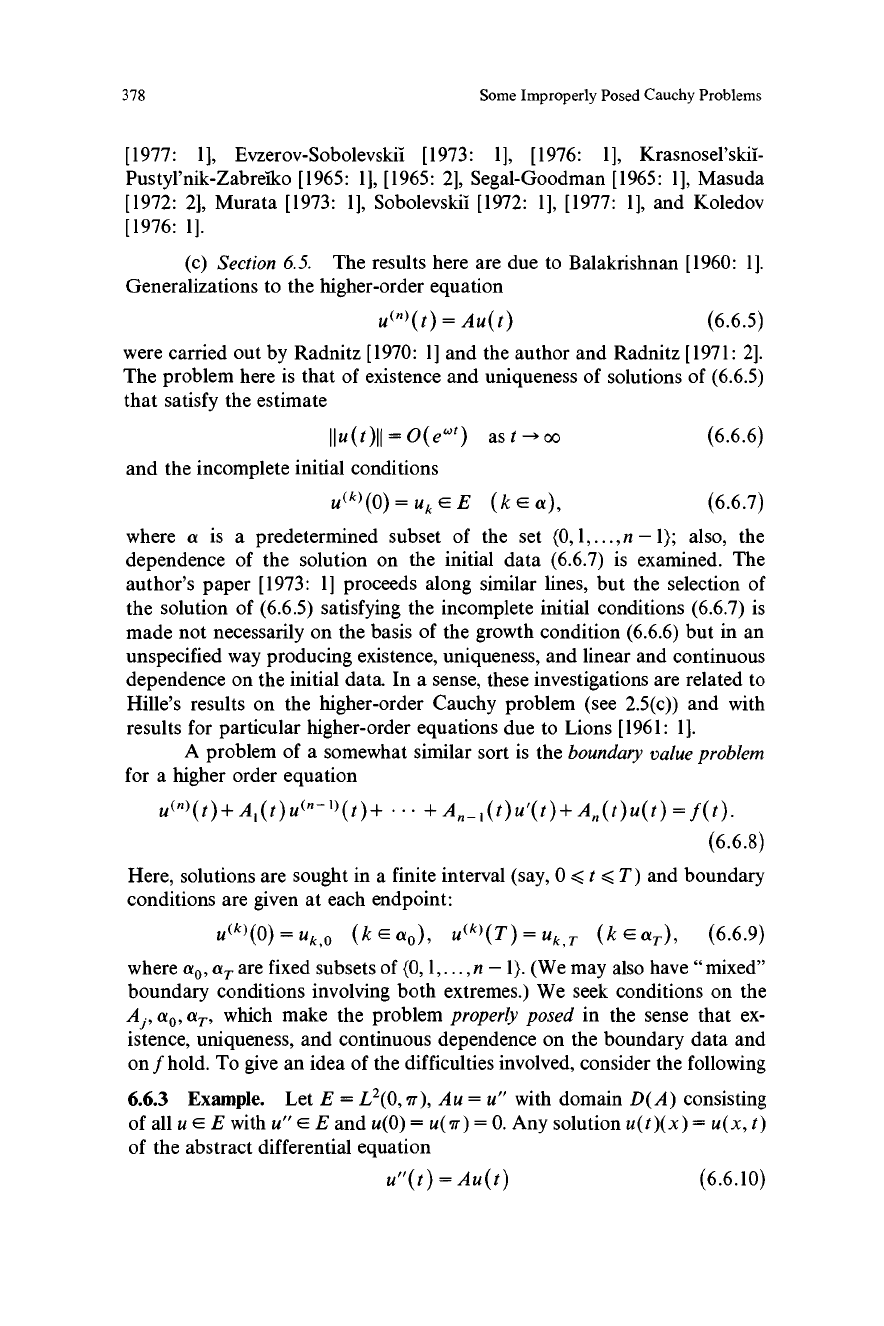
378 Some Improperly Posed Cauchy Problems
[1977:
11,
Evzerov-Sobolevskii [1973:
1],
[1976:
1],
Krasnosel'skii-
Pustyl'nik-Zabreiko [ 1965: 11, [1965: 2], Segal-Goodman [ 1965: 1 ], Masuda
[1972: 2], Murata [1973: 11, Sobolevskii [1972: 11, [1977: 11, and Koledov
[1976: 1].
(c) Section 6.5. The results here are due to Balakrishnan [1960: 1].
Generalizations to the higher-order equation
u(n)(t) = Au(t) (6.6.5)
were carried out by Radnitz [ 1970: 11 and the author and Radnitz [ 1971: 2].
The problem here is that of existence and uniqueness of solutions of (6.6.5)
that satisfy the estimate
IIu(t)II=O(e')
ast - oo
(6.6.6)
and the incomplete initial conditions
u(k)(0)=ukEE
(kEa), (6.6.7)
where a is a predetermined subset of the set (0, 1, ... , n - 1); also, the
dependence of the solution on the initial data (6.6.7) is examined. The
author's paper [1973: 1] proceeds along similar lines, but the selection of
the solution of (6.6.5) satisfying the incomplete initial conditions (6.6.7) is
made not necessarily on the basis of the growth condition (6.6.6) but in an
unspecified way producing existence, uniqueness, and linear and continuous
dependence on the initial data. In a sense, these investigations are related to
Hille's results on the higher-order Cauchy problem (see 2.5(c)) and with
results for particular higher-order equations due to Lions [1961: 1].
A problem of a somewhat similar sort is the boundary value problem
for a higher order equation
u(n)(t)+A,(t)u(n-')(t)+ .
+An-,(t)u'(t)+An(t)u(t) = f(t).
(6.6.8)
Here, solutions are sought in a finite interval (say, 0 < t < T) and boundary
conditions are (given at each endpoint:
u(k)(0) = Uk 0
(k E a0),
u(k'(T) = uk T
(k E aT), (6.6.9)
where a0, aT are fixed subsets of (0,1,...,n - 1). (We may also have "mixed"
boundary conditions involving both extremes.) We seek conditions on the
Aj, a0, aT, which make the problem properly posed in the sense that ex-
istence, uniqueness, and continuous dependence on the boundary data and
on f hold. To give an idea of the difficulties involved, consider the following
6.6.3
Example. Let E = L2(0,77), Au = u" with domain D(A) consisting
of all u E E with u" E E and u(0) = u(7r) = 0. Any solution u(t)(x) = u(x, t)
of the abstract differential equation
u"(t) = Au(t) (6.6.10)
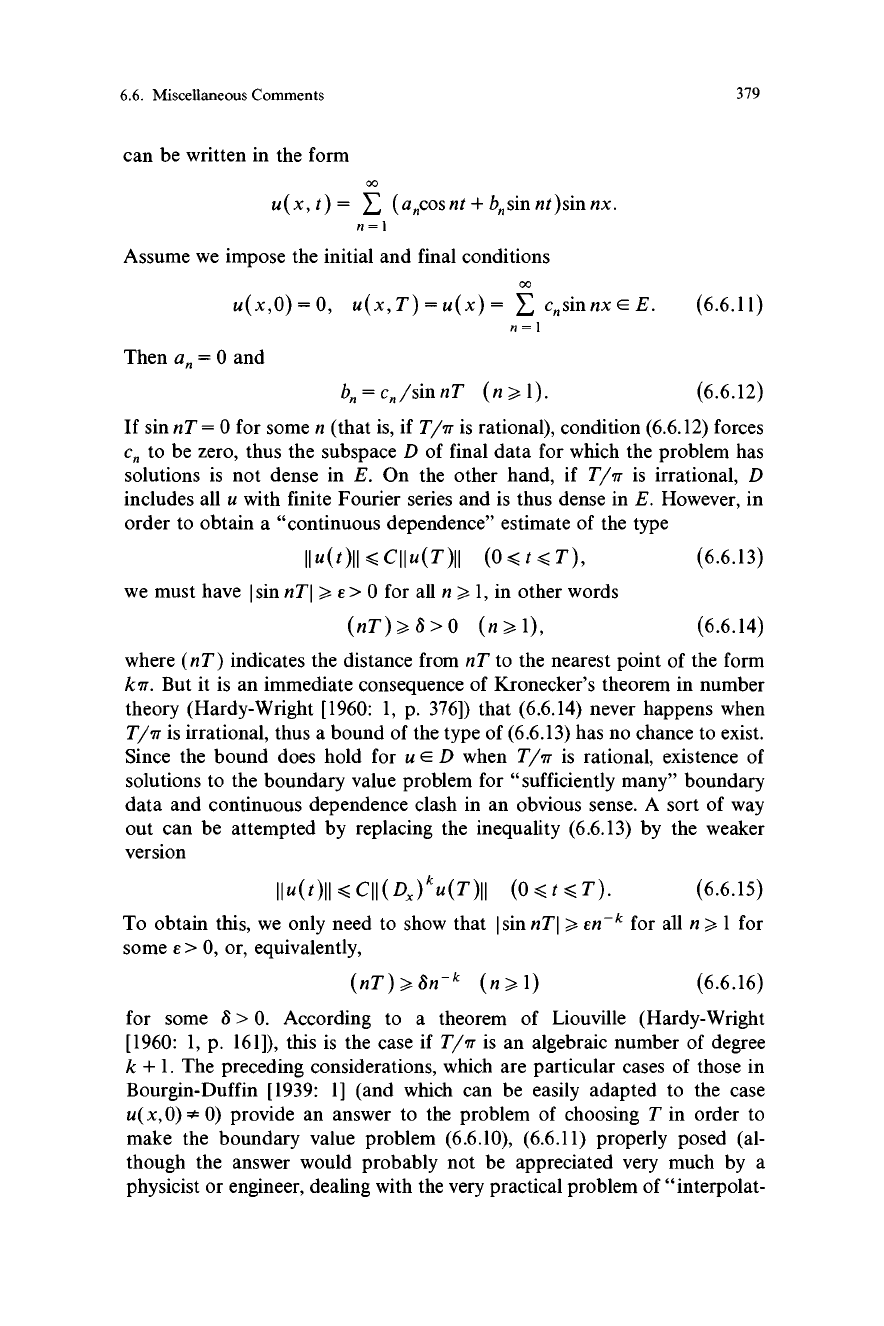
6.6. Miscellaneous Comments
379
can be written in the form
00
u(x,t)= E (ancosnt+bnsinnt)sinnx.
n=1
Assume we impose the initial and final conditions
00
u(x,0) = 0, u(x, T) = u(x) _ E cnsin nx E E. (6.6.11)
n=1
Then an = 0 and
bn=cn/sinnT (n>-l). (6.6.12)
If sin nT = 0 for some n (that is, if T/Ir is rational), condition (6.6.12) forces
cn to be zero, thus the subspace D of final data for which the problem has
solutions is not dense in E. On the other hand, if T/Ir is irrational, D
includes all u with finite Fourier series and is thus dense in E. However, in
order to obtain a "continuous dependence" estimate of the type
Ilu(t)II<cIIu(T)II
(0<t<T),
(6.6.13)
we must have I sin nT I >, e > 0 for all n >, 1, in other words
(nT) >, S>0 (n> 1),
(6.6.14)
where (nT) indicates the distance from nT to the nearest point of the form
kv. But it is an immediate consequence of Kronecker's theorem in number
theory (Hardy-Wright [1960: 1, p. 376]) that (6.6.14) never happens when
T/Ir is irrational, thus a bound of the type of (6.6.13) has no chance to exist.
Since the bound does hold for u E D when T/17 is rational, existence of
solutions to the boundary value problem for "sufficiently many" boundary
data and continuous dependence clash in an obvious sense. A sort of way
out can be attempted by replacing the inequality (6.6.13) by the weaker
version
Ilu(t)II<cII(Dx)ku(T)II
(0, t, T).
(6.6.15)
To obtain this, we only need to show that I sin nTI >_ en-k for all n >, 1 for
some e > 0, or, equivalently,
(nT) >, Sn-k
(n>_ 1)
(6.6.16)
for some S > 0. According to a theorem of Liouville (Hardy-Wright
[1960: 1, p. 161]), this is the case if T/ir is an algebraic number of degree
k + 1. The preceding considerations, which are particular cases of those in
Bourgin-Duffin [1939: 1] (and which can be easily adapted to the case
u(x,0) - 0) provide an answer to the problem of choosing T in order to
make the boundary value problem (6.6.10), (6.6.11) properly posed (al-
though the answer would probably not be appreciated very much by a
physicist or engineer, dealing with the very practical problem of "interpolat-

380
Some Improperly Posed Cauchy Problems
ing" the movement of a string, its position known at two times t = 0 and
t = T).
Although no necessary and sufficient conditions on the Aj(t ), T and
the sets a0, aT in order that the boundary value problem be well posed are
apparently known, even in the particular case where the Ai do not depend
on time, numerous results in both directions exist. Necessary conditions
regarding the number of boundary conditions and their distribution be-
tween the two endpoints were found by the author [1974: 1] for the equation
u(")(t) = Au(t)
(6.6.17)
using a modification of an idea of Radnitz [1970: 1] to obtain the resolvent
of A in terms of the solutions of (6.6.17), (6.6.9). The following references
deal mostly with sufficient conditions in order that the boundary value
problem (6.6.8), (6.6.9) be properly posed in various senses; most of the
material is on second-order equations with one boundary condition at each
endpoint, or with mixed boundary conditions involving both endpoints.
See the treatise of Krein [1967: 1] and Krein-Laptev [1962: 1], [1966: 1],
[1966: 2], Favini [1975:
21, Gorbacuk-Koeubei [1971:
1],
Gorbacuk-
Gorbacuk [1976: 1], Honig [1973: 11, Jakubov [1973: 1], Jurcuc [1974: 1],
[ 1976: 11, [1976: 2], Kislov [ 1972: 1], [1975: 1 ], Kutovoi [ 1976: 1 ], McNabb
[1972: 11, McNabb-Schumitzky [1973:
11, [1974:
11, Mihailec [1974: 11,
[ 1975: 11, Misnaevskii [ 1976: 11, Orudzev [ 1976: 11, Pavec [ 1971: 11, Romanko
[1976:
1], [1977:
1], Venni [1975: 11, Laptev [1966:
11, [1968:
11, J. M.
Cooper [ 1971: 1 ], and Karasik [ 1976: 1 ].
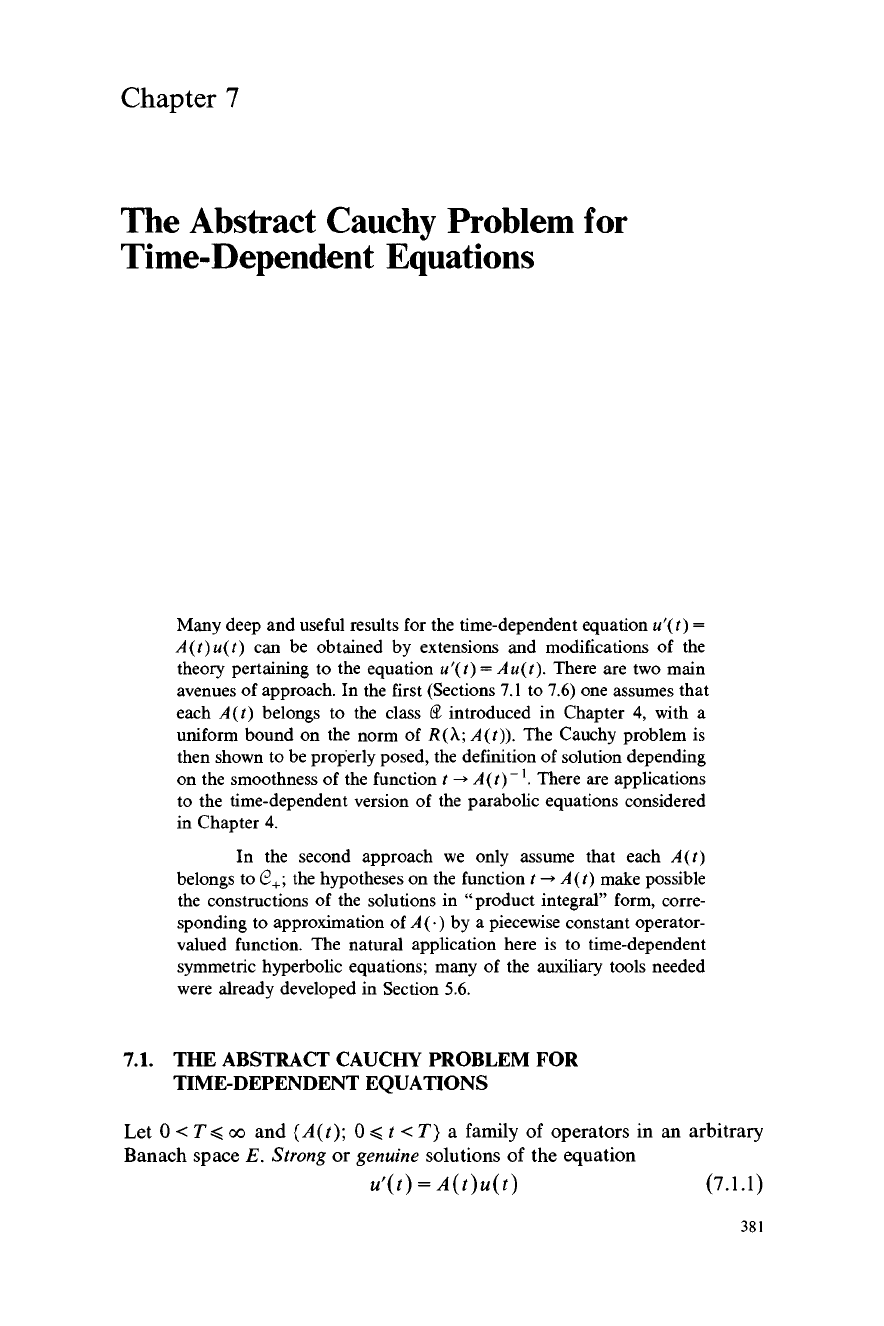
Chapter 7
The Abstract Cauchy Problem for
Time-Dependent Equations
Many deep and useful results for the time-dependent equation u'(t) =
A(t)u(t) can be obtained by extensions and modifications of the
theory pertaining to the equation u'(t) =A u(t). There are two main
avenues of approach. In the first (Sections 7.1 to 7.6) one assumes that
each A(t) belongs to the class d introduced in Chapter 4, with a
uniform bound on the norm of R(X; A(t)). The Cauchy problem is
then shown to be properly posed, the definition of solution depending
on the smoothness of the function t - A(t)-'. There are applications
to the time-dependent version of the parabolic equations considered
in Chapter 4.
In the second approach we only assume that each A(t)
belongs to C'+; the hypotheses on the function t -> A(t) make possible
the constructions of the solutions in "product integral" form, corre-
sponding to approximation of A(.) by a piecewise constant operator-
valued function. The natural application here is to time-dependent
symmetric hyperbolic equations; many of the auxiliary tools needed
were already developed in Section 5.6.
7.1. THE ABSTRACT CAUCHY PROBLEM FOR
TIME-DEPENDENT EQUATIONS
Let 0 < T < oo and (A(t ); 0 5 t < T) a family of operators in an arbitrary
Banach space E. Strong or genuine solutions of the equation
u'(t)=A(t)u(t)
(7.1.1)
381

382
The Abstract Cauchy Problem for the Time Dependent Equations
in any interval I contained in 0 < t < T are defined, as in the time-indepen-
dent case, to be continuously differentiable functions
such that u(t) E
D(A) and (7.1.1) is satisfied everywhere in I.
We shall say that the Cauchy problem for (7.1.1) is well posed (or
properly posed) in 0 < t < T if the following two assumptions are satisfied:
(a) (Existence of solutions for sufficiently many initial data) There
exists a dense subspace D of E such that for every s, 0 < s < T and
every u0 E D there exists a solution t -* u(t, s) of (7.1.1) in
s<t<Twith
u(s,s) = u0. (7.1.2)
(b) (Continuous dependence of solutions on their initial data) There
exists a strongly continuous (E)-valued function S(t, s) defined in
the triangle 0 < s < t < T such that if u(t, - ) is a solution of (7.1.1)
in s < t < T, we have
u(t, s) = S(t, s)u(s, s).
(7.1.3)
The operator S will be called the propagator (or evolution operator or solution
operator) of (7.1.1). Because of the uniform boundedness theorem, (b)
implies
IIS(t,s)II<C (0<s<t<T')
(7.1.4)
for any T' < T, so that the label given to (b) is justified. Note that solutions
depend continuously not only on their initial data, but also on the time s at
which these data are imposed. It is clear that when A(t) = A and T = oo, our
definition is equivalent to that in Section 1.2 for the time-independent
Cauchy problem. Just as in there, if 0 < s < T and u0 E E, we call the
function
u(t) = S(t, s)u0 (7.1.5)
a generalized solution of (7.1.1). We shall discuss later the relation among
generalized solutions of (7.1.1) and weak solutions (that is, solutions in the
sense of distributions).
Note that (b) implies that D is contained in D(A(s)) for any s in
[0, T), thus the set
n D(A(t))
(7.1.6)
O<t<T
must be dense in E. This imposition can be avoided if need be by requiring
the solution u( , s) in (a) to satisfy (7.1.1) only in 0 < s < T (but, naturally,
retaining continuity in 0 < s < T to give sense to the initial condition) or by
allowing D to depend on s, in which case D(s) c D(A(s)) and denseness of
each D(s) only implies denseness of the domain of each A(s), hardly an
extravagant assumption. Unlike in the time-independent case, the definition

7.1. The Abstract Cauchy Problem for Time-Dependent Equations
383
of solution of (7.1.1) is critical, and several different notions will have to be
used below.
The following two equalities are obtained in the same way as (2.1.2):
S(s,s)=I (0<s<T),
(7.1.7)
S(t,r)S(r,s)=S(t,s) (0<s<r<t<T).
(7.1.8)
We note finally that the notion of properly posed Cauchy problem
can be formulated equally well in intervals other than [0, T).
The case where the operators A(t) are everywhere defined and
depend continuously of t in one way or another is of scarce interest to us for
the reasons already pointed out in the time-independent case in Section 1.2.
However, the results are considerably less trivial when A(t) is not a constant
function and we include one of them, which is an infinite-dimensional
extension of a classical theorem on existence and uniqueness of solutions of
systems of ordinary differential equations.
7.1.1 Theorem.
Let A(t) be bounded and everywhere defined in
0 < t < T; moreover, let t - A(t) E (E) be strongly continuous in 0 < t < T.
Then the Cauchy problem for (7.1.1) is properly posed in 0 < t < T and the
function (s, t) -* S(t, s) E (E) is continuous in 0 < s < t <T.
Proof.
The proof is a standard application of the successive ap-
proximation method. We begin by observing that if u0 E E, the differential
equation (7.1.1) and the initial condition (7.1.2) are equivalent to the single
integral equation[
u(t, S) = uo + f 'A(T)u(T, s) dT. (7.1.9)
We take u0(t) ° u0 as initial approximation and define the following ones
recursively by
un(t,s)=u0+ f'A(T)un-t(T,s)dT,
(n=1,2,...). (7.1.10)
By the uniform boundedness theorem, if T' < T
IIA(t)II<C
(0<t<T'),
(7.1.11)
which yields, via a simple inductive argument applied to (7.1.10), the
If v(-) is a continuous E-valued function, A v
is continuous. This is a simple
consequence of the strong continuity of A(.) and of the bound (7.1.1 1). This will be used many
times in the sequel.

384
The Abstract Cauchy Problem for the Time Dependent Equations
sequence of inequalities
IIun(t s)- un-1(i s)II <
Cn(n, S)nIluoll
(n=1,2,...) (7.1.12)
in s < t < T'. Accordingly, the series Ell un (t, s) - un _ 1(t, s )I I converges (and
thus u(t, s) = lim un(t, s) exists) uniformly on 0 < s < t < T'. Taking limits
in (7.1.10), we see that u(
, s)
is a solution of (7.1.9) and then a solution of
the initial-value problem (7.1.1), (7.1.2).
To prove uniqueness of u(t, s) and continuity of the solution opera-
tor, we make use of the following result (Gronwall's lemma), which we state
in a version more general than necessary now, with a view to future use.
7.1.2 Lemma.
Let /3 be locally integrable and nonnegative in t >-a.
Assume the nonnegative continuous function q(t) satisfies
i(t)<a+ f`fO(s)rt(s)ds
(7.1.13)
a
in t >_ a, where a >, 0. Then
in tea.
fi(t)<aexp(f'/3(s)ds) (7.1.14)
a
Proof. We assume first that a > 0. It follows from (7.1.13) that
$(t)rl (t)(a+ f r$(s)n(s)
ds)
<$(t)
(t >,a).
Integrating from a to t gives
log(a+ f'#(s),q(s) ds)-loga< f 1$(s)
ds,
whence (7.1.14) follows using again (7.1.13). The case a = 0 is dealt with
taking a -* 0+.
We go back to the uniqueness problem. Let u(t, s) be a solution of
(7.1.9) in s < t < T'. If we set ra(t) = II u(t, s)II, we have
(t)<Iluoll+C
f'n(s)ds,
(7.1.15)
S
thus it follows from Lemma 7.1.2 that
Il u(t, s)II < ec('-s)lluoll
(s < t <T'),
(7.1.16)
which shows that u(t, s) = 0 if uo = 0. Since T' < T is arbitrary, existence
and uniqueness of the solution is established in s < t < T for any s < T. We
note, incidentally, that the arguments leading to existence and uniqueness of
the solutions of (7.1.1) work just as well for t < s as for t >_ s so that
solutions actually exist in 0 < t < T' (i.e., the Cauchy problem can be solved
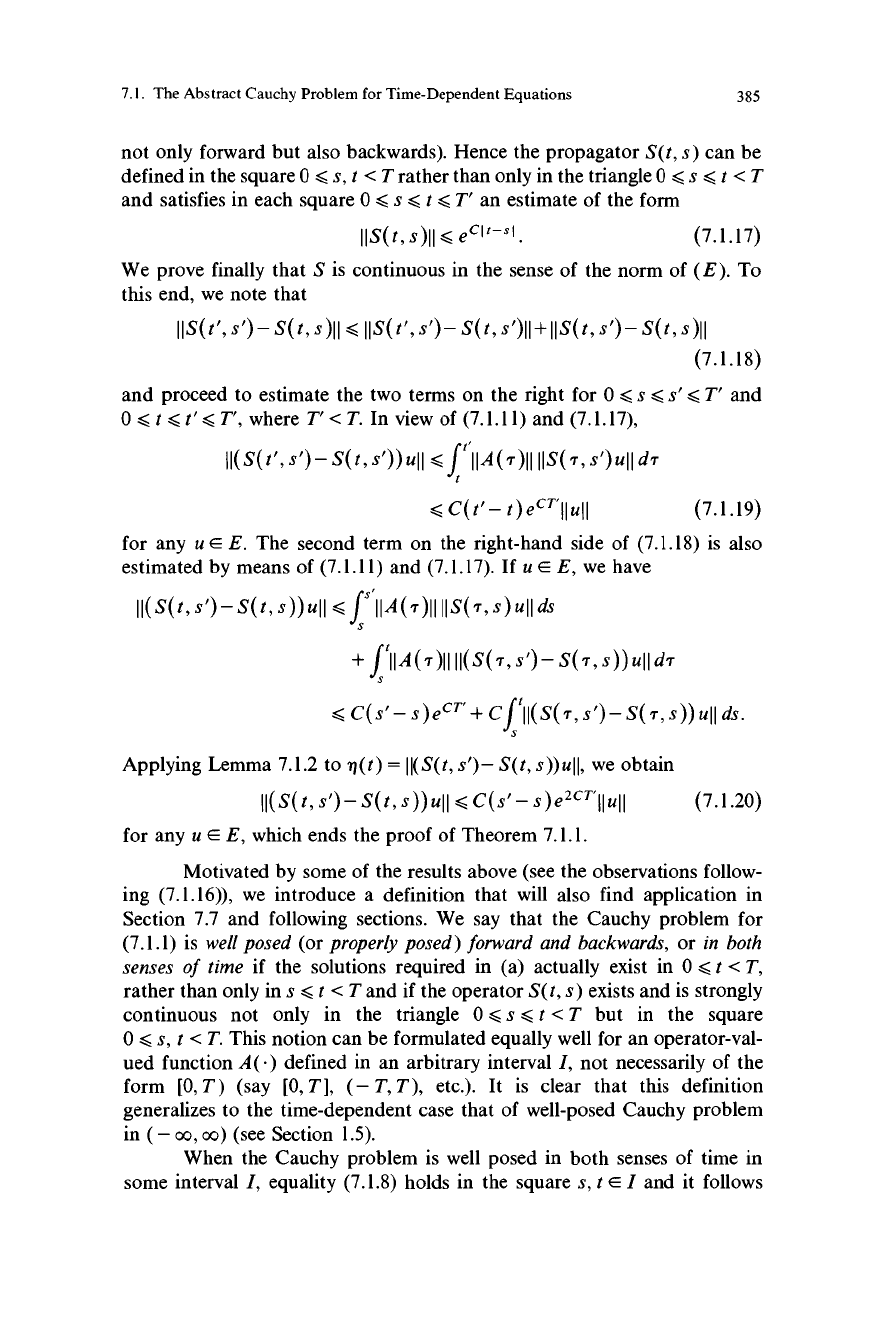
7. I. The Abstract Cauchy Problem for Time-Dependent Equations
385
not only forward but also backwards). Hence the propagator S(t, s) can be
defined in the square 0 < s, t < T rather than only in the triangle 0 < s < t < T
and satisfies in each square 0 < s < t < T' an estimate of the form
IIS(t,s)II
<eCIt-SI.
(7.1.17)
We prove finally that S is continuous in the sense of the norm of (E). To
this end, we note that
IIS(t', s') - S(t, s)II < IIS(t', s')- S(t, s')II+IIS(t, s') - S(t, s)II
(7.1.18)
and proceed to estimate the two terms on the right for 0 < s < s'< T' and
0 < t < t'< T', where T' < T. In view of (7.1.11) and (7.1.17),
II(S(t',s')-S(t,s'))uII < f tIIA(T)IIIIS(T,s')uIIdT
t
<C(t'-t)eCT IIuII
(7.1.19)
for any u E E. The second term on the right-hand side of (7.1.18) is also
estimated by means of (7.1.11) and (7.1.17). If u E E, we have
II(S(t,s')-S(t,s))uII <
JS
IIA(T)II1IS('r,s)ullds
S
+
f'IIA(T)IIII(S(T,S')-S(T,s))uIIdT
S
<C(s'-s)eCT CTf tII(S(T,S')-S(T,S))uII dS.
Applying Lemma 7.1.2 to rl(t) = II(S(t, s')- S(t, s))uII, we obtain
II(S(t,s')-S(t,s))uII <C(s'-s)e2CT'IIuII
(7.1.20)
for any u E E, which ends the proof of Theorem 7.1.1.
Motivated by some of the results above (see the observations follow-
ing (7.1.16)), we introduce a definition that will also find application in
Section 7.7 and following sections. We say that the Cauchy problem for
(7.1.1) is well posed (or properly posed) forward and backwards, or in both
senses of time if the solutions required in (a) actually exist in 0 < t < T,
rather than only in s < t < T and if the operator S(t, s) exists and is strongly
continuous not only in the triangle 0 < s < t < T but in the square
0 < s, t < T. This notion can be formulated equally well for an operator-val-
ued function A(.) defined in an arbitrary interval I, not necessarily of the
form [0, T) (say [0, T], (- T, T), etc.). It is clear that this definition
generalizes to the time-dependent case that of well-posed Cauchy problem
in (- oo, oo) (see Section 1.5).
When the Cauchy problem is well posed in both senses of time in
some interval I, equality (7.1.8) holds in the square s, t E I and it follows
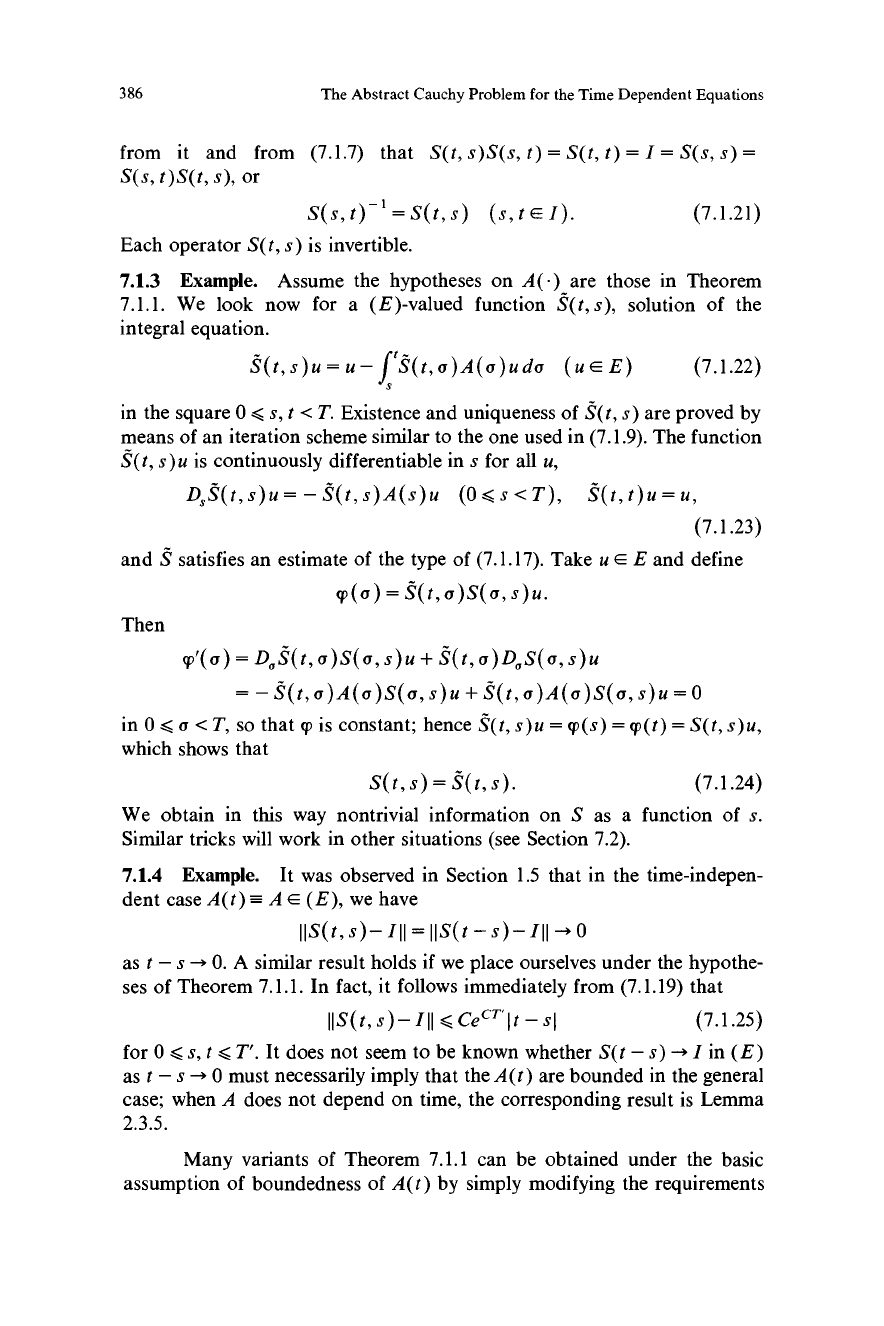
386
The Abstract Cauchy Problem for the Time Dependent Equations
from it and from (7.1.7) that
S(t, s)S(s, t) = S(t, t) = I = S(s, S) _
S(s, t)S(t, s), or
S(s,t)-t=S(t,s) (s,tEl). (7.1.21)
Each operator S(t, s) is invertible.
7.1.3 Example. Assume the hypotheses on A(.) are those in Theorem
7.1.1. We look now for a (E)-valued function 9(t, s), solution of the
integral equation.
S(t,s)u=u- ftS(t,a)A(a)udr (uEE) (7.1.22)
S
in the square 0 < s, t < T. Existence and uniqueness of S(t, s) are proved by
means of an iteration scheme similar to the one used in (7.1.9). The function
S(t, s)u is continuously differentiable in s for all u,
D,S(t,s)u=-S(t,s)A(s)u (0<s<T),
S(t,t)u=u,
(7.1.23)
and S satisfies an estimate of the type of (7.1.17). Take u E E and define
q9 (a) = S(t, a)S(a, S) U.
Then
DgS(t, a)S(a, s)u + S(t, a)DQS(a, s)u
S(t, a)A(a)S(a, s) u + S(t, a)A(a)S(a, s) u = 0
in 0 < a < T, so that p is constant; hence S(t, s)u = q9 (s) = q) (t) = S(t, s)u,
which shows that
S(t, S) = S(t, s). (7.1.24)
We obtain in this way nontrivial information on S as a function of s.
Similar tricks will work in other situations (see Section 7.2).
7.1.4
Example.
It was observed in Section 1.5 that in the time-indepen-
dent case A(t) = A E (E), we have
IIS(t,s)-III =1IS(t-s)-III ->0
as t - s - 0. A similar result holds if we place ourselves under the hypothe-
ses of Theorem 7.1.1. In fact, it follows immediately from (7.1.19) that
IIS(t,s)-III'< Cec'°It
- sl (7.1.25)
for 0 < s, t < T. It does not seem to be known whether S(t - s) -* I in (E)
as t - s - 0 must necessarily imply that the A(t) are bounded in the general
case; when A does not depend on time, the corresponding result is Lemma
2.3.5.
Many variants of Theorem 7.1.1 can be obtained under the basic
assumption of boundedness of A(t) by simply modifying the requirements
